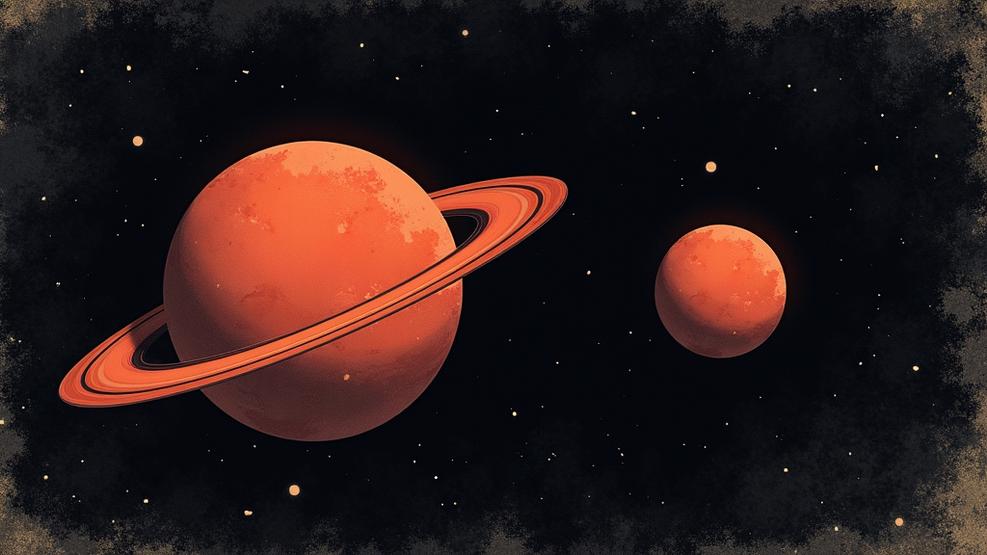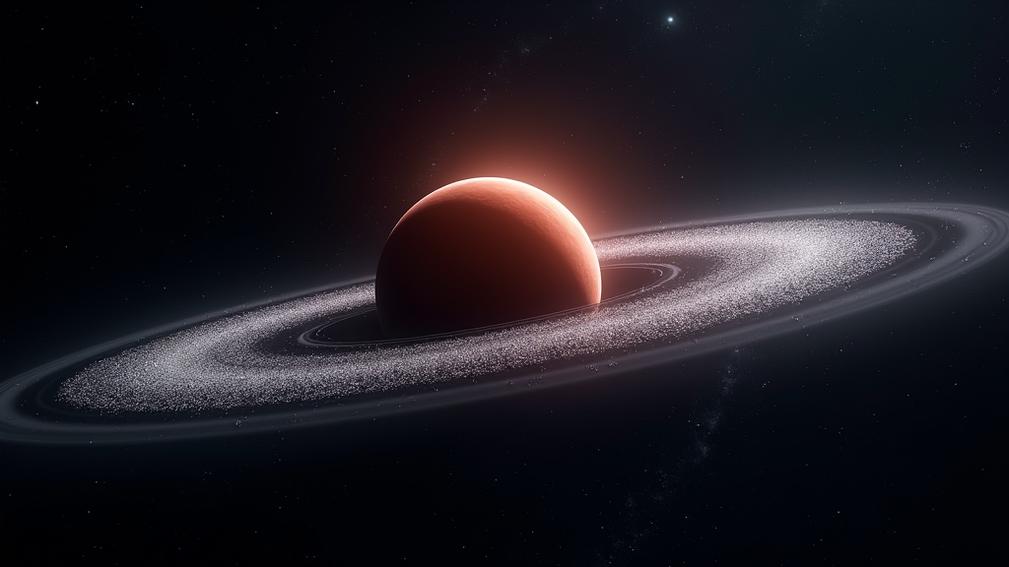Quaoar: Definition, Rings, Orbit, Discovery, Size
Quaoar is a dwarf planet candidate located in the Kuiper Belt beyond Neptune. American astronomers Chad Trujillo and Michael Brown discovered Quaoar on June 4, 2002, at the Palomar Observatory. Quaoar has a diameter of approximately 1,090 kilometers (680 miles), making it one of the largest known Kuiper Belt objects. Quaoar’s surface contains crystalline water ice, ammonia hydrate, and methane, giving it a moderately reddish color. Quaoar possesses a ring system and a moon called Weywot, measuring roughly half its size. Quaoar orbits the Sun at an average distance of 43.6 astronomical units, completing one rotation every 285 Earth years. NASA’s New Horizons spacecraft measured Quaoar’s size in 2016 using occultation observations, estimating its mean radius at 555 kilometers. Quaoar’s volume equals about 0.02 times Pluto’s volume, making it smaller than both Pluto (2,374-kilometer diameter) and Charon (1,208-kilometer diameter).
What is a dwarf planet Quaoar?
Quaoar is a dwarf planet candidate located in the Kuiper Belt, a region of icy bodies beyond Neptune. American astronomers Chad Trujillo and Michael Brown discovered Quaoar on June 4, 2002, at the Palomar Observatory. Quaoar has a diameter of approximately 1,090 kilometers (680 miles), making it one of the largest known objects in the Kuiper Belt. The dwarf planet’s surface contains crystalline water ice, ammonia hydrate, and a small amount of methane, appearing moderately reddish in color. Quaoar possesses a ring system and a moon called Weywot, which measures roughly half the size of Quaoar.
Does Quaoar have rings?
Quaoar, a dwarf planet beyond Neptune, possesses a ring system. Researchers discovered the ring using the Hubble Space Telescope and W.M. Keck Observatory. The ring measures 4-12 kilometers in diameter with an 8.2-kilometer width. Quaoar’s ring lies 4,100 kilometers from its center, within the Roche limit of 4,500 kilometers. The ring’s location challenges previous theories about ring formation.
Quaoar’s ring system includes a possible second ring. Evidence suggests the presence of an additional, fainter ring more distant than the confirmed one. Astronomers using the Hubble Space Telescope detected a potential ring in 2013, but the data was inconclusive. Older sources incorrectly stated Quaoar had no rings. Early studies and observations did not reveal the presence of rings around Quaoar. Improved technology and recent discoveries have revealed Quaoar’s ring system, making it one of the few known objects in the solar system with rings.

What is the orbit of Quaoar?
Quaoar orbits the Sun at an average distance of 43.6 AU. Its nearly circular orbit has an eccentricity of 0.038 and an inclination of 8 degrees. Quaoar completes one orbit in 285 Earth years. Michael Edwards Brown and Chadwick Aaron Trujillo discovered Quaoar in 2002. Quaoar’s distance varies from 28 AU at perihelion to 45 AU at aphelion.
How long is a year on Quaoar?
Quaoar’s year lasts approximately 285 Earth years. Quaoar completes one orbit around the Sun in this time period. Quaoar’s orbital period is comparable to other Kuiper Belt objects like Haumea (284 Earth years) and Makemake (310 Earth years). Scientists determined Quaoar’s year length through astrometry and spectroscopy observations of its orbital period.
Quaoar orbits the Sun at an average distance of 43.6 astronomical units. The dwarf planet’s eccentric orbit causes slight variations in its orbital period estimates. Quaoar’s distance from the Sun varies throughout its year, affecting its orbital period. Astronomers continue to monitor Quaoar’s orbit and occultations to refine their understanding of its characteristics. An occultation event in 2013 provided valuable information about Quaoar’s size, shape, and orbit.
How far is Quaoar from the Sun?
Quaoar orbits the Sun at an average distance of 43.6 Astronomical Units (AU). Quaoar’s distance varies due to its elliptical orbit. Perihelion occurs at 41.9 AU from the Sun. Aphelion reaches 45.3 AU. Quaoar’s current distance measures approximately 43.8 AU as of 2021. Quaoar completes one orbit around the Sun in 288 Earth years.
Astronomers approximate Quaoar’s distance from the Sun as 6 billion km or 4 billion miles for simplicity. A specific measurement puts Quaoar’s distance from the Sun at 6,400,000,000 km. Quaoar orbits the Sun in a highly eccentric path within the Kuiper Belt. Quaoar lurks in the outer reaches of the solar system, making detailed surface studies challenging. Astronomers have been studying Quaoar’s orbit since its discovery in 2002. Quaoar will potentially encounter Neptune at a distance of around 41 au or 43 au in the future.
When was Quaoar discovered?
Quaoar was discovered on June 4, 2002, by astronomers Chad Trujillo and Michael Brown from the California Institute of Technology. They used the Samuel Oschin Telescope at Palomar Observatory. The discovery was announced on October 7, 2002, at an American Astronomical Society meeting. Quaoar is a significant Kuiper Belt object, classified as a dwarf planet.
How did Quaoar get its name?
Quaoar’s name originated from Tongva mythology. Native American Tongva people from the Los Angeles area suggested the name, meaning “creator” in their language. Astronomers proposed it to the International Astronomical Union. The name reflects Tongva cultural heritage and their connection to the sky. Quaoar is pronounced “KWAH-o-wahr”.
The naming of Quaoar follows conventions established by the International Astronomical Union for non-resonant Kuiper Belt objects. These objects are named after creator deities from various cultures. Astronomers Michael Brown and Chad Trujillo proposed the name Quaoar to honor the cultural heritage of the Tongva tribe. The International Astronomical Union officially approved the name on August 4, 2004. Quaoar’s name serves as a tribute to the rich cultural legacy of the Tongva people and their creation stories.
What is the size of Quaoar?
Quaoar’s diameter is approximately 850 kilometers, with a 10% uncertainty. NASA’s New Horizons spacecraft measured Quaoar’s size in 2016 using occultation observations. Quaoar’s mean radius is estimated at 555 kilometers. Quaoar’s volume equals about 0.02 times Pluto’s volume. Quaoar is smaller than Pluto’s 2,374-kilometer diameter and Charon’s 1,208-kilometer diameter.
What is the mass of Quaoar?
Quaoar’s mass is approximately 1.4 x 10^21 kg. Large uncertainty of 0.04 x 10^21 kg exists due to density estimation challenges. Scientists calculate Quaoar’s mass using its volume of 2.5 x 10^6 km3 and estimated mean density of 2 g/cm^3. Researchers rely on these measurements to determine Quaoar’s mass accurately.
What is the radius of Quaoar?
Quaoar’s radius measurements vary. NASA’s Jet Propulsion Laboratory reports an average radius of 443.5 km. Other sources indicate a radius of 555 km. Occultation observations and thermal infrared measurements determined these values. Quaoar is classified as a trans-Neptunian object and Kuiper Belt object. Scientists consider Quaoar a dwarf planet candidate.


